| On September 2, 1953, 40 trainees with the 406th Engineer
Training Brigade at Fort Bragg, North Carolina were given a
demonstration ride aboard an engineer pontoon raft on nearby Smith
Lake. The raft was actually two pontoons tied together. The
raft overturned when the men moved to one side of the raft as it
took on water after hitting a large wave. Twenty trainees,
many of whom could not swim, drowned. Lt. Vale G. Bruner was in
charge of the training. Although the 20 victims of this tragedy did not serve in Korea, they were serving
their country in the Army when the accident happened. Sadly,
one family member told me that her brother's name was not allowed on
a local veterans monument because his death was not caused by combat
in a war zone. On that fateful day in 1953, 20 veterans died.
It is not right that their lives were snuffed out and there is
little trace of their existence now.
To add information to this page contact
Lynnita; phone
217-253-4620 in Illinois; or write Lynnita Brown, 111 E. Houghton
St., Tuscola, IL 61953. Lynnita is usually home in the
evening.
Table of Contents:
Back to Page Contents
Fatalities:
List of Fatalities:
- Alton, George E.
- Beach, Pvt. Frank Colvin
- Byron, Thomas J.
- Carpenter, John R.
- Carpenter, Lowell E.
- Carson, Ted
- Daw, Pvt. Edward C.
- DeCormier, Arnold F.
- Fasano, Pvt. Bramie R. Jr.
- Hedley, Pvt. James T.
- Jones, William Thomas
- Loughnane, Thomas Robert "Bobby"
- Michaud, Cyprien
- Peets, Pvt. Frank Bennett
- Pond, Pvt. Charlie R.
- Reed, Pvt. John Foster
- Spicer, Pvt. Donald F.
- Stone, John Clifton
- Troiano, Pvt. Peter Jr.
- Turney, Pvt. Dan Arthur
Back to Page Contents
Fatalities - Personal Profiles
Alton, George Elwood
This 20 year old victim was born March 21, 1933, a son of Frank
F Alton Sr. (1902-1969) and Katie P. Robie Alton (1904-1941),
Route 1, Harmony, Maryland. His siblings were Harry L.
(1929-2002), Velma E. Alton Gibbs (1932-2013), Eugene L.
(1936-2013), Emogene L. (1936-1937), Rowena Witham, Carroll
"Cal" Alton, and Frank "Fred" Alton Jr. George is buried
in West Ripley Cemetery, Ripley, Maine.
Beach, Pvt. Frank Colvin
Private Beach was born in 1933, and was survived by his
mother, Mrs. Laura W. Beach of Williamson, New York. He is
buried in Rose Cemetery, Rose, New York.
The Fair Haven Register
September 10, 1953
Drowning Victim Had Furlough Due
Pfc. Frank Colvin Beach. 19, only son of Mrs. Laura W. Beach
of Williamson, was one of the 20 Army Engineer trainees who
drowned Wednesday of last week at Fort Bragg, N.C.
Pfc. Beach was known in Wolcott by his middle name. He was
born October 3, 1934, in North Rose, a graduate of Williamson
Central school class of 1952. He worked as a meat cutter for the
Liddle Market, Williamson, before entering service on May 25. He
was sent to Fort Devens, Massachusetts, for a week and then to
Fort Bragg.
Pfc. Beach was expected home this weekend for his first
furlough. He was the only living close relative his mother had.
Pfc. Beach was a member of Williamson Baptist church.
Byron, Thomas J.
Age 19, he was born on October 13, 1934. He was the
husband of Dorothy Byron, 169 Borden St., Fall River,
Massachusetts. He is buried in St. Patrick's Cemetery,
Fall River.
Carpenter, John Reeves Sr.
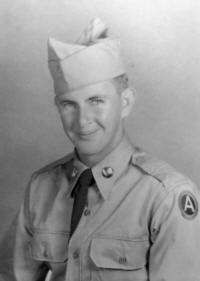
John Reeves Carpenter Sr.
(Click picture for a larger view)
|
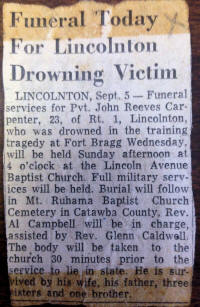
Newspaper Clipping of John Carpenter's Funeral
(Click picture for a larger view)
|
John Reeves Carpenter (service number US-53124890) was born October 1, 1929,
in Lincolnton County, North Carolina, a son of David
Andrew and Ella Annie Caldwell Carpenter. The
husband of Bonnie Lee Cody Carpenter (now Mrs. Claude Poovey), Lincolnton, North Carolina, he was 23 years old.
In addition to his wife and father, he was survived by an as-yet unborn
son, John Reeves Carpenter Jr., three sisters, Mrs.
Cole (Esther Mae Carpenter) Clark, Mrs. John (Edith Carpenter)
Dellinger, and Mrs. Wallace (Martha Elizabeth Carpenter) Bell,
all of
Lincolnton, and a brother, Fred Carpenter of Route 1,
Lincolnton. He was preceded in death by another brother,
Robert Julius Carpenter. John Reeves Carpenter, Sr. is buried in Mt. Ruhama Baptist Church Cemetery, Catwaba County, North Carolina.
He enlisted in the Army on August 7, 1953 and was a member of
Company A, 981st Engineer Construction Battalion. According to John's sister Edith, the military people from Ft.
Bragg said that John lost his life trying to save the life of
another man who pulled him under the water.
Carpenter, Lowell E.
Age 20, Lowell was born June 20, 1933, a son of Russell S.
Carpenter Sr. (1897-1969) and Agnes C. Peterson Carpenter
(1902-1978). His siblings were Russell Stanley Carpenter Jr.
(1929-1999), Stephen E. Carpenter (1938-2011), and Miles E.
Carpenter. Lowell is buried in Seekonk Cemetery, Seekonk,
Massachusetts.
Carson, Ted
Son of Mr. and Mrs. Johnson Gill Carson, Rt. 15, West Tulsa, Oklahoma. Ted
was 21 years old. [FAMILY CONTACTS NOT YET FOUND.]
Daw, Pvt. Edward C.
Age 19, his mother was Mrs. Ruth Mead of Croton on Hudson,
New York. He was born in 1934, son of Vern and Ruth Daw.
[FAMILY CONTACTS NOT YET FOUND.]
DeCormier, Arnold F.
Age 20, Arnold "Sonny" DeCormier was born July 14, 1933, the son of Nedd A. and Frances K. Holland
DeCormier of Lisbon Falls, Maine. He also had a sister
Barbara Louise, who was married to Richard C. Porter of
Washburn, Maine on June 23, 1951. Arnold was preceded in
death by a baby sibling who was born and died November 3, 1940. He is buried in Hillside Cemetery,
Lisbon Falls.
Fasano, Pvt. Bramie R. Jr.
Age 19 at the time of the accident, he was from New York.
He was the son of Mr. and Mrs. Bramie Fasano Sr., and the
brother of Gloria Fasano (Farnholz) and Marjorie Fasano.
Mrs. Farnholz is now deceased. Bramie's only nephew is
James R. Farnholz, a history teacher in New York.
Services Held for Private Fasano, Drowning Victim
[Source: The Avon Herald-News, Avon, New York, September 10,
1953, page 1] "Last rites were held Tuesday morning, September 8, for Pvt.
Bramie R. Fasano, 19, of Retsof, who lost his life by drowning
in a training accident at Fort Bragg, North Carolina.
Services were held from the Rector and Sons Funeral Chapel in
Geneseo and from St. Lucy's Church in Retsof, with the Rev.
Charles Reynolds officiating. The Noble-Samara Post No.
955, American Legion of Retsof conducted military rites, and
burial was in St. Mary's Cemetery, Geneseo. Classmates and
friends from York Central School, where Pvt. Fasano was
graduated in 1951, served as bearers. They were Roger
Clouser, Paul Batzing, Roy Stewart, Frank Elliott, Robert
Carney, and Jack Rigney.
The young soldier's body arrived at the Mt. Morris depot,
early Sunday morning, accompanied by Pvt. Orlando. An
honor guard from the Noble-Samara Post, with Arthur McCaughey,
commander, and a large number of friends met the train.
Private Fasano is survived by his parents, Mr. and Mrs.
Bramie Fasano, Sr., of Retsof; two sisters, Marjorie and Gloria,
at home; his grandfather, Michael Fasano, 103, of Retsof; and
his fiancee, Martha McCoy of Georgia. His mother operates
the Carousel Restaurant in Geneseo, and his father is an
employee of the Town of York. Miss Marjorie Fasano is
secretary of the Livingston County Public Health Service with
offices in Geneseo, and Miss Gloria Fasano is to graduate this
week from the school of nursing at Wyoming County Community
Hospital in Warsaw.
The family, on hearing Wednesday night of a drowning accident
at Fort Bragg, which involved boys in the 408th Engineer
Brigade, called the camp and were informed that Pvt. Fasano
could not be located at that time but that everything was all
right and not to be concerned. Thursday morning an
Associated Press reporter called at the Fasano home in Retsof to
obtain information concerning Bramie, and moments later a wire
arrived in Geneseo with the tragic news.
The accident in which the young Retsof man lost his life has
been called the worst non-aerial disaster since World War II.
Staff officers said the accident occurred when an
outboard-powered raft, consisting of joined pontoons, capsized.
The raft, designed for 25 persons, carried 40 soldiers.
The 22 victims, members of Company A, 981st Engineer
Construction Battalion, a unit of the 406th Engineer Brigade,
were engaged in river crossing training. The craft had
proceeded up the 10-foot deep Smith Lake, located on the base,
and turned back, hitting the wave caused by its passage up the
lake. Some of the men moved back, apparently in panic,
when water was shipped over the bow, and the boat capsized,
within 100 yards from shore.
The men were dumped into the water, a screaming, struggling
mass, an officer said. They were wearing loose fitting
fatigues, combat boots, and ammunition belts, but were not
equipped with life savers. Several of them were unable to
swim.
According to report, Pvt. Fasano could have got to shore.
His body and that of a buddy were the first to be recovered,
just a few feet from shore. Fasano and the buddy whom he
was assisting were recovered in less than five minutes after the
accident. Army medical companies worked over the young
Retsof man's body for three hours, a friend said, getting a
faint response once. When the bodies were taken from the
water, the arms of the friend he was trying to save were locked
about his neck, according to a third man who was swimming close
to the two, and who survived to tell the story. One
witness said that Bramie and his buddy were as close as three
feet from the shore when they went down.
Pvt. Fasano entered the service this summer and was
undergoing his eight weeks basic training at Fort Bragg.
He was well known throughout Livingston County as a star
athlete, having played full-back on the York Central School
football team, of which he was co-captain, and having been
catcher on the baseball team. Before entering the service
he was employed for a time at the Market Basket Store in Geneseo
and the Mt. Morris Dam project."
Hedley, Pvt. James T.
Private Hedley was 20 years old and the son of Mrs. Tillie
Hedley, Buffalo, New York. At the time of the accident his
address was Matanuska Susitna Borough, Alaska. [FAMILY CONTACTS NOT YET FOUND.]
Jones, William Thomas
Age 24, William left a widow, Shirley F. Jones, in Charlotte,
North Carolina. He was born February 4, 1929, son of Mr.
and Mrs. William M. Jones, and is buried in Evergreen Burial
Park, Mint Hill, North Carolina.
Loughnane, Thomas Robert "Bobby"
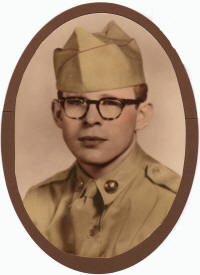
Private Thomas Robert Loughnane
(Click picture for a larger view) |
Age 19 at the time of his death, "Bobby" Loughnane did not
know how to swim. He was survived by his mother, Mrs. Mary E. Loughnane,
2 Lincoln St., Worcester, Massachusetts; brothers John J. (Jack)
(died 1998) of Leicester, Bernard F. of Worcester (died 1980), and Master
Sergeant James E. Loughnane (died 1977), stationed in Labrador;
and sisters Mrs. Nelson (Rita) Occhialini of Winchendon (died
1987), Mrs. Edward O. (Grayce) Asselin of Worcester (died 2011),
and Dorothy
Lawrence (died 2002), and several nieces and nephews.
Bobby Loughnane was born in Worcester, the son of Joseph B.
(died 1938) and Mary E. Brosnihan Loughnane (died 1961).
He graduated from Worcester Boy's Trade High School in 1952.
Before entering service on May 23, 1953, he was employed at
Patten Company, Inc., 142 Green Street, Worcester.
Callahan Brothers Funeral Home handled his funeral arrangement
at the Church of Our Lady of Fatima. Burial was in St.
John's Cemetery.
Michaud, Cyprien (Cyr)
Age 20, he was born January 23, 1933 in Eagle Lake, Maine, a
son of George A. Michaud (1888-1971) and Ida Daigle Michaud
(1895-1983). His siblings were Leonard, George, Edmond,
Bertrand (1918-1991), Carmen (1928-2006), Reginald (1914-1944),
Camille (1916-1916), Bernadette T. Michaud Simard (1920-2007),
Gerald (1921-122), Joe and Estelle. He is buried in Saint
Mary Catholich Cemetery, Eagle Lake. He was a member of
the 981st Engineer Construction Battalion at the time of the
accident.
Peets, Pvt. Frank Bennett
Frank was born in Mayfield, New York on December 22, 1933, a
son of James Garfield Peets and Olive Fredenburg Peets. He
was a member of the 981st Engineer Training Company at Ft.
Bragg. According to his brother Frederick Peets, Frank
tried to enlist in the Army but was rejected due to a heart
murmur. The next year, he was drafted and sent to Ft.
Bragg for basic training. Frank was survived by his
parents, brother Frederick Peets, and sisters Florence Peets,
Evelyn Peets, and Elizabeth Peets. He also had a
half-sister, Virginia Jones. Frank is buried in Ferndale
Cemetery, Johnstown, New York.
Pond, Pvt. Charles R.
Charles, the son of Karl W. and Hazel A. (Underwood) Pond, was born
in 1932 in Burke, New York. His father was the mayor of
the Village of Burke. Charlie was a 1945 graduate of Chateaugay
High School, NY, and attended Clarkson College for one year. He
entered the US Army and eventually was assigned to Company A,
981st Engineer Construction Battalion, Fort Bragg, North
Carolina. On September 2, 1953, while on training maneuvers, a
boat with trainees aboard, capsized and 20 drowned, including
Charlie. In May, 1954, Charles was posthumously awarded the
Soldier's Medal for saving two lives. It was learned that when
he was returning to the boat to save others, he became
exhausted, and drowned. The incident had wide reaching
ramifications regarding military training. Private Pond
is buried in Burke Center Cemetery, Burke, New York. He
was survived by his parents and a sister Shirley. Shirley
Pond Whitehead still lives in New York.
Reed, Pvt. John Foster
Private Reed, age 20, was the son of John Carroll
Reed (1909-1988) and Dorothy Foster Reed (1912-1967), 31 York Ave., Saratoga Springs, New York.
John Foster Reed was
born August 3, 1933. He is buried in Saint Peters Cemetery,
Sarasota Springs, New York.
Spicer, Pvt. Donald F.
Private Spicer was 19 years old, and the son of Mrs. Alice
Spicer, 249 E. 8th St., Oswego, New York. He was born in October 1934,
one of 23 children of Willard M. and Alice Wager Spicer of
Oswego.
Willard died in October of 1951. Private Spicer was survived by a son, Don Spicer.
His siblings included: brothers James A., Ken R., Milton,
Gerald, and Kevin; and sisters Betty J. Baker, Janet L. Meskers,
Beverly Morgia, Mildred Connolly, Karen Murtha, Mary A. Peolo,
Marlene Raponi, and Geraldine (Gerri) Jones. Contact with the
family was made 2/27/2013 and more information about Donald will
be added soon.
Stone, John Clifton
Age 18, he was the son of Mr. and Mrs. Horace J. Stone,
Saugus, Massachusetts. [FAMILY CONTACTS NOT YET FOUND.]
Troiano, Pvt. Peter Jr.
Peter was 20 years old and the son of Mrs. Marge Troiano,
298 Hudson St., Buffalo, New York. [FAMILY CONTACTS NOT YET
FOUND.]
Turney, Pvt. Dan Arthur
Dan was the son of Donald D. and Martha A. Robbins Turney of
New York. Age 20 years and 15 days at the time of the accident, Private
Turney was a member of Company A, 406th Engineer Training
Brigade, 981st Engineer Construction Battalion at Ft. Bragg. Private Dan Turney is buried in Maple
Grove Cemetery, Frewsburg, New York.
According to information in "Drowned GI's Body to Be Sent
Home for Burial" in the Jamestown [New York] Post-Journal
newspaper dated September 4, 1953, Private Turney attended
Frewsburg schools and was employed at the American Manufacturing
Company in Falconer prior to his induction into the Army on May
26 [1953]. He was married on May 1, 1953 to Theresa Bink
at Adrian, Michigan. She was residing in Corydon,
Pennsylvania at the time of Dan's death, and she was pregnant
with his son, also Dan Turney, now of Jamestown, New York.
Survivors in addition to his wife included his parents, Mr. and
Mrs. Donald B. Turney, 12 Washington Street, Frewsburg; one
sister, Mrs. Ralph J. (Grace D. Turney) Long, 65 Frew Run
Frewsburg; a nephew, Ralph Long Jr., and several aunts and
uncles.
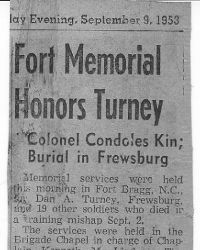
Newspaper clipping
(Click picture for a larger view) |

Newspaper clipping
(Click picture for
a larger view) |
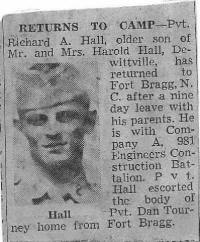
Newspaper clipping
(Click picture for a larger view) |

Letter from Fort Bragg Headquarters
(Click picture for a larger view) |
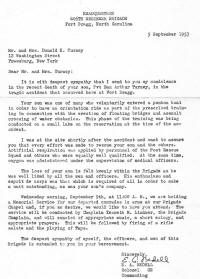
Letter from 406th Engineer Brigade Headquarters
(Click picture for a larger view) |

Letter from Third Army Headquarters
(Click picture for a larger view) |
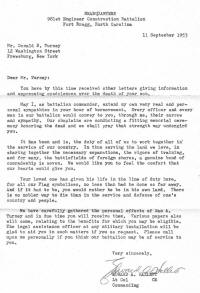
Letter from 981st Engineer Construction Battalion Headquarters
(Click picture for a larger view) |

Telegram from Fort Bragg
(Click picture for a larger view) |

Inventory of Effects
(Click picture for a larger view) |

Personal Effects (continued)
(Click picture for a larger view) |
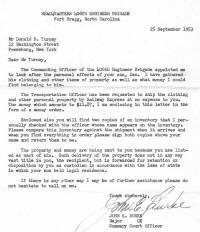
Letter from 406th Engineer Brigade Headquarters
(Click picture for a larger view) |

Letter from 406th Engineer Brigade Headquarters
(Click picture for a larger view) |

Order to Report for Induction
(Click picture for a larger view) |

Letter from 406th Engineer Brigade Headquarters
(Click picture for a larger view) |
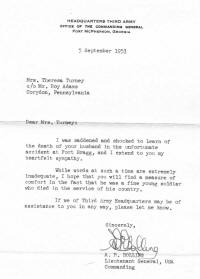
Letter from Third Army Headquarters
(Click picture for a larger view) |

Letter from Military Pay Division
(Click picture for a larger view) |
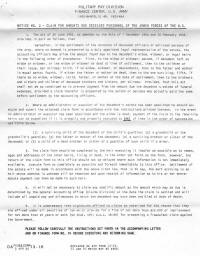
Letter from Military Pay Division
(Click picture for a larger view) |
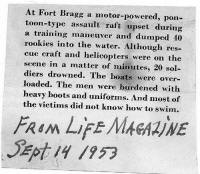
Clipping from Life Magazine
(Click picture for a larger view) |

Newspaper Clipping
(Click picture for a larger view) |
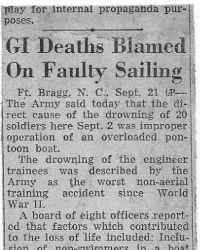
Newspaper Clipping
(Click picture for a larger view) |

Portrait of Pvt. Dan Turney and Mrs. Theresa Turney
(Click picture for a larger view) |
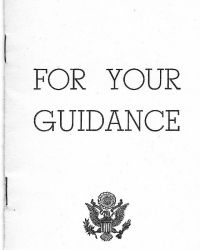
Army Pamphlet 20-15
(Click picture for a larger view) |
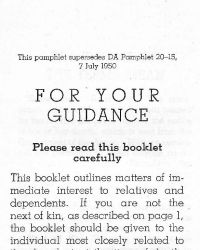
Army Pamphlet 20-15
(Click picture for a larger view) |
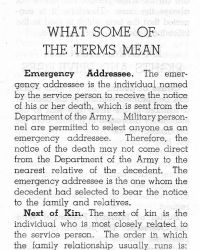
Army Pamphlet 20-15
(Click picture for a larger view) |
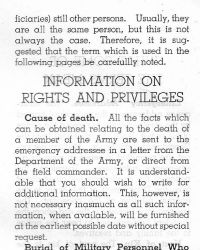
Army Pamphlet 20-15
(Click picture for a larger view) |

Army Pamphlet 20-15
(Click picture for a larger view) |
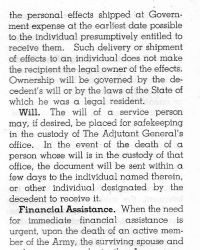
Army Pamphlet 20-15
(Click picture for a larger view) |

Army Pamphlet 20-15
(Click picture for a larger view) |

Army Pamphlet 20-15
(Click picture for a larger view) |
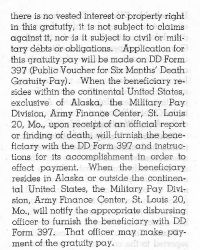
Army Pamphlet 20-15
(Click picture for a larger view) |
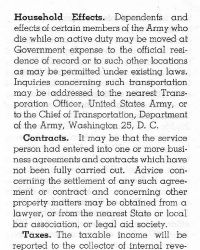
Army Pamphlet 20-15
(Click picture for a larger view) |
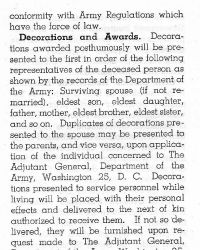
Army Pamphlet 20-15
(Click picture for a larger view) |
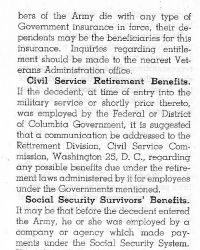
Army Pamphlet 20-15
(Click picture for a larger view) |
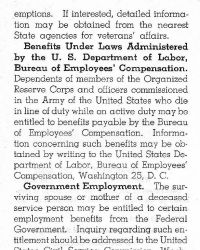
Army Pamphlet 20-15
(Click picture for a larger view) |
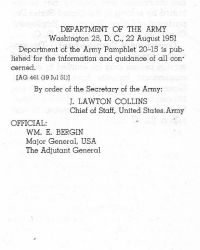
Army Pamphlet 20-15
(Click picture for a larger view) |
|
Back to Page Contents
Accident Details - Newspaper Articles
The Daily Chronicle Centralia Washington 1953-09-02
18 SOLDIERS ARE DROWNED IN LAKE DURING MANEUVERS
Ft Bragg, N. C. (AP) -- The Ft. Bragg Public Information
Office reported that 18 soldiers drowned Wednesday in an
accident during a training program. The PIO said two other
soldiers were "not accounted for" and four others were
hospitalized. Details of the accident were lacking, but
authorities said it occurred during a "routine training problem"
by members of the 406th Engineers Brigade at Smith's Lake on
this big Army reservation. The men were building a pontoon
bridge across a lake at the time of the accident, the PIO said.
The accident occurred about 10:15 a.m. and all the bodies had
been recovered three hours later. Medical officers were rushed
to the scene and gave artificial respiration in a vain effort to
revive the men. The four who were hospitalized were
brought to the post hospital in helicopters.
Names of the dead will not be released until next-of-kin have
been notified the PIO said. A board was appointed to investigate
the cause of the accident. Complete details of the accident were
being withheld pending the board's investigation.
The Daily Chronicle Centralia Washington 1953-09-03
PANIC BLAMED FOR DROWNINGS
Ft. Bragg, N. C. (AP) -- The Army indicated Thursday that
panic caused the drowning of 20 soldiers in a lake on the Ft.
Bragg Reservation Wednesday. In an informal report, staff
officers said the accident occurred when a military craft,
carrying 40 soldiers, capsized. They denied that the boat was
overloaded.
The victims, members of Co. A. 891st Engineer Construction
Battalion, a unit of the 406th Engineer Brigade, were engaged in
river crossing training. "The men were being given an
orientation ride by an engineer pontoon boat which consists of
two engineer assault boats ...." the report said. "There were 40
men on the trip ... Their only equipment was a cartridge belt
and canteen." "They were not wearing life preservers and
it's not normal for this type of training. The boat had
proceeded up the lake and turned back, hitting the wave caused
by its passage up the lake and (the boat) shipped water over the
bow. This caused some of the men to move back, apparently in
panic which caused the boat to capsize."
"Several other boats were immediately sent to the scene and
succeeded in rescuing several men. The men who had been assisted
to the overturned boat failed to use it for support, probably
due to panic." "All men in the boat were seated up to the
time of the accident and there was no horseplay ..."
The report said Lt. Vale G. Bruner was in charge of the
training "and he was observing and enforcing all normal safety
precautions ... "
Avoidable Army Tragedy - Jamestown [NY] Post-Journal, Friday,
Sept. 4, 1953 [Editorial]
"Reports of the tragic drowning of 20 soldiers, including one
from Frewsburg, Pvt. Dan A. Turney, on a routine training cruise
at Fort Bragg, N.C., records what appears to have been a
shocking disregard of the value of human life by someone in
authority. it is a case calling for a prompt, searching
and complete investigation by higher military authorities with
swift and adequate punishment for superiors found to be
responsible for the needless loss of life.
there just is no excuse for the sending of 40 service men out
on a training mission in two assault craft bolted together which
normally carry a load of only 25 men. It was a clear case
of overloading, a reckless and inexcusable risking of life.
But not only was there an overloading of the training craft.
It also appears that some of the 40 young men could not swim.
That probably explains the heavy death toll. It does not
explain the astonishing failure of the Army to make sure that
every engineer is trained to swim before he is sent out on
training craft.
The awful tragedy at Fort Bragg is brought close to home by
the death list which includes Private Turney, who entered the
service as a nearby Frewsburg resident. We join in a
community wide expression of sympathy to the widow and parents
of the young engineer. Fortunately, other Jamestown area
residents survived the shocking disaster at Fort Bragg.
For that we can be grateful."
"Eighteen Soldiers Drowned in Smith's Lake, " The
Fayetteville Observer, September 2, 1953
Excerpts -
"P.W. Sparrow, city editor of the Fayetteville Observer, and
William Shaw, photographer, were escorted from the scene by a
lieutenant of the military police. Fay Ridenhour,
free-lance photographer, also was ushered away from Smith's
Lake. They were later permitted to return after the
newspaper telephoned Colonel Tipton, chief of staff. He
provided them with an escort. Before he was ushered from
the tragedy, Sparrow reported seeing the bodies of two dead
soldiers removed from the lake. He said both seemed to be
Negroes and that they were dressed in fatigue clothing.
As far as could be ascertained from Fort Bragg authorities
rescue operations started immediately after the accident.
Fort Bragg and Fayetteville fire departments and rescue boats
and resuscitators to the scene. Medical officers rushed to
the scene, administered artificial respiration to the men as
fast as they were dragged from the waters of the lake but sparks
of life were restored to only four of the victims. These
four were picked up by Army helicopters, similar to the ones
used in frontline evacuation of Korean wounded, and flown to the
Fort Bragg Hospital. Indications were that they would
recover."
"According to P.W. Sparrow of The Fayetteville Observer,
the following details were learned at the scene of the tragedy:
Twenty-two men were in a metal boat, some 25 feet in length,
near the middle of the lake when the boat overturned. In
the next few minutes 18 of the men who had been in the boat
drowned, while four escaped from the pond. Two of the men
were reported to have reached shallow water in good condition,
but the other two who escaped were carried to the Station
hospital at Fort Bragg for treatment. The men who had been
in the boat were all apparently clothed in fatigue uniforms and
each wearing a fatigue cap, paratrooper boots, a canteen and a
cartridge belt."
"Most of the bodies were found in a small area near the
center of the pond in about 10 feet of water. At one time,
late this morning when bodies were being recovered in rapid
order, a number of corpses were lined up on stretchers on the
lake shore, while the search continued for men still missing.
As each body was recovered from the lake and brought ashore, an
examination was made by a medical officer before the dead man
was placed in an ambulance.
Rescue squads from Fayetteville and Fort Bragg were on the
scene soon after the accident was reported. Some eight to
ten boats, each equipped with hooks for dragging the lake
bottom, were placed in use. When a number of the drowned
men had been removed from the lake a rope was stretched across
the pond. Crews pulled boats equipped with drags from one
side of the lake to the other by means of the heavy rope.
After one sweep across the lake the heavy rope would be moved 10
to 15 feet and another sweep made across the lake.
It was reported at the scene that at least one of the men who
had been in the boat which overturned swam to within a few feet
of the lake shore before he disappeared beneath the surface of
the water. As the bodies were brought ashore the men were
identified by their dog tags and their names were checked off a
list of soldiers believed to be missing in the lake. All
types of rescue equipment were at the scene, but the job of
finding the bodies was left to the boat crews with their drag
lines. Early this afternoon a number of expert swimmers
were on the scene to aid the dragging crews by diving to the
lake bottom in search of bodies."
"Probe of Drownings At Fort Bragg Continues," The
Fayetteville Observer Sept. 4, 1953
Excerpt -page 1
"By figuring the weights of the 40 men on the pontoon boat
and knowing that the boat was rated up to a capacity of six
thousand pounds, Army authorities found the boat to be
overloaded by 123 pounds. However, investigating Engineer
officers stated that the 6,000-pound capacity of the of the boat
was for running water, for use in crossings and construction
work on fast moving streams. In their opinion the pontoon
boat was not overloaded for use on a small still body of water
like Smith Lake."
Back to Page Contents
Soldier's Medals Awarded
[A Soldier's Medal is issued for heroism not involving actual
conflict with an enemy. Source of citations: General Orders
No. 26, Department of the Army, 2 April 1954]
Back to Page Contents
Bebeau, Gordon P.
Corporal Gordon P. Bebeau, Quartermaster Corps, United States
Army, a member of the 612th Quartermaster Aerial Supply Company,
981st Engineer Construction Battalion, distinguished himself by
heroism at Fort Bragg, North Carolina, on 2 September 1953.
Corporal Babeau saw a boat loaded with soldiers overturn on
Smith Lake. Immediately upon arriving at the scene, with
total disregard for his personal safety and realizing the
danger, he unhesitatingly entered the water in an attempt to
rescue his fellow soldiers. He pulled one man out of the
water and placed him in a rescue boat. Then, with great
presence of mind, he continued in the rescue work until all
bodies were recovered. Corporal Bebeau's alertness and
prompt heroic actions reflect great credit on himself and the
military service.
Back to Page Contents
Derby, Eugene P.
Private Eugene P. Derby, Corps of Engineers, United States
Army, a member of Company A, 981st Engineer Construction
Battalion, distinguished himself by heroism at Fort Bragg, North
Carolina, on 2 September 1953. Private Derby was aboard an
assault boat with other members of the company when the boat
overturned, causing panic among all the passengers. With
total disregard for his personal safety and realizing the
danger, he swam to the aid of one of the passengers and placed
him on the overturned boat, where he was picked up later by a
rescue boat. He then aided in the rescue work until all
bodies were recovered. Private Derby's great presence of
mind and indomitable courage reflect great credit on himself and
the military service.
Back to Page Contents
Pond, Charles R. (posthumous)
Private Charles R. Pond, Corps of Engineers, United States
Army, a member of Company A, 981st Engineer Construction
Battalion, distinguished himself by heroism at Ft. Bragg, North
Carolina, on 2 September 1953. Private Pond was a member
of an assault boat crew operating a boat which was participating
in a class on Light Stream Crossing Equipment (Infantry Support
Raft). In making a turn, the boat started to ship water
and the passengers shifted to one side, causing it to overturn.
Approximately one-half of the passengers were unable to swim.
Private Pond, who was a swimmer, remained calm and began to
place non-swimmers on the overturned boat. With complete
disregard for his safety, he swam to the nearest bank with a
non-swimmer, a feat which he repeated twice. On a
subsequent trip to the scene of the accident, he became
exhausted and called for assistance, but the rescue boat could
not reach him in time to save him from drowning. Private
Pond's courageous and heroic action in this emergency prevented
the loss of life of several of his fellow soldiers and reflects
great credit on himself and the military service.
Back to Page Contents
Randell, Ernest F.
Private Ernest F. Randell, Corps of Engineers, United States
Army, a member of Company A, 981st Engineer Construction
Battalion, distinguished himself by heroism at Fort Bragg, North
Carolina, on 2 September 1953. Private Randell was a
member of an assault-boat crew when the boat overturned on Smith
Lake. All the men in the water were in a state of panic.
With total disregard for his personal safety and realizing the
danger, he unhesitatingly attempted to rescue his fellow
soldiers. He saw a man floundering in the water. A
5-gallon gas can was floating nearby and Private Randell pushed
it to the man. The man grasped it and remained afloat
until rescued from the water. While swimming for shore, he
came upon another man, whom he assisted to a place of safety.
Private Randell's prompt actions an indomitable courage reflect
the highest credit on himself and the military service.
Back to Page Contents
Rouleau, Andre R.
Private Andre R. Rouleau, Corps of Engineers, United States
Army, a member of Company A, 981st Engineer Construction
Battalion, distinguished himself by heroism at Fort Bragg, North
Carolina, on 2 September 1953. Private Rouleau was a
member of the crew of an assault boat which overturned on Smith
Lake. The men in the water were in a state of panic.
With total disregard for his personal safety and realizing the
danger, he attempted to rescue his fellow soldiers.
Private Rouleau placed non-swimmers on the overturned boat and
proceeded to swim to shore. He came upon a man floundering
in the water and immediately took the man in tow and aided him
to shore, thus saving the life of a comrade. Private
Rouleau's alertness and prompt heroic actions reflect great
credit on himself and the military service.
Back to Page Contents
Eye Witness Accounts
Allen, Joseph (survivor)
[Source: The Fayetteville Observer September 3, 1953]
"I can't swim," Allen declared. "I was sitting on a
solid casing between the two M2s joined together. Water
started coming over the straight front section of the boat when
we were about in the middle of the lake. At first it came
slowly, then came fast. No body shouted as far as I
remember, We were too scared to say anything and too busy
saving ourselves. I remember someone telling me always
hang on the boat. So I went down with it, thinking it
would come up. It didn't at first so I let go. Then
I was drowning. Men were floundering all around. The
bodies felt like dead weights. The ones who could swim
were trying to help those who couldn't. I owe my life to
Pvt. Eugene Derby, my own age, who pulled me over to the boat.
It finally came up again. I kept slipping off the boat,
trying to sit on on it and trying to grab on it. The
rescue boats came closer and closer. But it seemed like
hours before they saved me. At least one of the four of
five men hanging on it let go and drowned before help arrived."
Back to Page Contents
Green, Cpl. George (now of Florida)
[Source: E-mail to the Korean War Educator February 2013]
Yes, I was there. Strangely enough, it happened on my 20th
birthday, one I'll NEVER forget. A boyhood hometown neighbor
(John Reed) of Saratoga Springs, New York was one of those
twenty accident victims.
Our company, Company A, 981st Engineer Battalion, 3rd Army,
had just finished dismantling a 'Pontoon-type bridge'. It was a
very hot day, and all had gone well in the training exercise, so
the person in charge suggested that we could take a short trip
up the lake in one of the motorized barges used, to cool off .
I, being a non-swimmer, chose not to take part, as the barge
quickly filled up with volunteers. I watched them head up
the lake a few hundred yards, then turn around to return for
another load, when it dipped into a wave swell created by the
turn process, and slipped rapidly under into 20-plus feet of
water. It didn't at first appear serious, but then the
realization hit home. It was hard to believe all the confusion
we observed.
I ran up the shoreline to where some survivors had managed to
reach land, and found John where he had been placed on the
beach, and began first aid. I performed artificial respiration
on John until I was instructed to cease. Having to accompany a
friend and neighbor home to his family was one of the most
traumatic experiences one could ever experience.
I witnessed both "heroism and cowardice" that day. Fellow
trainees were diving into the water to help all they could,
while some cadre 'backed off' and watched from a distance. I
probably shouldn't label their behavior as cowardice, but at the
time it sure appeared as such to me, because recruits were
working feverishly, as best they could under the circumstances!
Most of us had never experienced witnessing sudden death up
close before. I saw a few fellow trainees swim out again
and again, hauling friends to shore. One, Bramie Fasano, I
believe he was from the Buffalo NY area, worked himself to the
point of exhaustion swimming in and out, until he failed to
return from his final venture looking for survivors. His body
was recovered much later. He was a true hero!
Time has erased many names of others involved, but thanks for
giving me an opportunity to put a different perspective on a
terrible event.
The Fayetteville Observer, September 2, 1953.]
"P.W. Sparrow, city editor of the Fayetteville Observer, and
William Shaw, photographer, were escorted from the scene by a
lieutenant of the military police. Fay Ridenhour,
free-lance photographer, also was ushered away from Smith's
Lake. They were later permitted to return after the
newspaper telephoned Colonel Tipton, chief of staff. He
provided them with an escort. Before he was ushered from
the tragedy, Sparrow reported seeing the bodies of two dead
soldiers removed from the lake. He said both seemed to be
Negroes and that they were dressed in fatigue clothing.
As far as could be ascertained from Fort Bragg authorities
rescue operations started immediately after the accident.
Fort Bragg and Fayetteville fire departments and rescue boats
and resuscitators to the scene. Medical officers rushed to
the scene, administered artificial respiration to the men as
fast as they were dragged from the waters of the lake but sparks
of life were restored to only four of the victims. These
four were picked up by Army helicopters, similar to the ones
used in frontline evacuation of Korean wounded, and flown to the
Fort Bragg Hospital. Indications were that they would
recover."
"According to P.W. Sparrow of The Fayetteville Observer,
the following details were learned at the scene of the tragedy:
Twenty-two men were in a metal boat, some 25 feet in length,
near the middle of the lake when the boat overturned. In
the next few minutes 18 of the men who had been in the boat
drowned, while four escaped from the pond. Two of the men
were reported to have reached shallow water in good condition,
but the other two who escaped were carried to the Station
hospital at Fort Bragg for treatment. The men who had been
in the boat were all apparently clothed in fatigue uniforms and
each wearing a fatigue cap, paratrooper boots, a canteen and a
cartridge belt."
"Most of the bodies were found in a small area near the
center of the pond in about 10 feet of water. At one time,
late this morning when bodies were being recovered in rapid
order, a number of corpses were lined up on stretchers on the
lake shore, while the search continued for men still missing.
As each body was recovered from the lake and brought ashore, an
examination was made by a medical officer before the dead man
was placed in an ambulance.
Rescue squads from Fayetteville and Fort Bragg were on the
scene soon after the accident was reported. Some eight to
ten boats, each equipped with hooks for dragging the lake
bottom, were placed in use. When a number of the drowned
men had been removed from the lake a rope was stretched across
the pond. Crews pulled boats equipped with drags from one
side of the lake to the other by means of the heavy rope.
After one sweep across the lake the heavy rope would be moved 10
to 15 feet and another sweep made across the lake.
It was reported at the scene that at least one of the men who
had been in the boat which overturned swam to within a few feet
of the lake shore before he disappeared beneath the surface of
the water. As the bodies were brought ashore the men were
identified by their dog tags and their names were checked off a
list of soldiers believed to be missing in the lake. All
types of rescue equipment were at the scene, but the job of
finding the bodies was left to the boat crews with their drag
lines. Early this afternoon a number of expert swimmers
were on the scene to aid the dragging crews by diving to the
lake bottom in search of bodies."
Back to Page Contents
Sylvester, Frank M.
[The following information arrived at the Korean War Educator's
office on March 05, 2014 from eye witness Frank M. Sylvester, Chief
of Department, Lime Rock Fire District, Lincoln, Rhode Island.]
"I am the one that contacted you after I read your article on
the internet. I was surprised to see the research and
information that you were trying to gather for the tragedy which
took place at Fort Bragg, North Carolina on September 2, 1953.
My name is Frank M. Sylvester. I was a member of the
406 Brigade, 981st Construction Engineers Battalion. My
service number is U.S.51266286. Being an eye witness to
the drowning of the 20 Trainees that day, I feel I had the Good
Lord or my deceased father looking down and protecting me from
the same fate.
I remember there were questions about the 27 foot platoon
boat being overloaded. In my opinion, knowing then and
knowing now that the boat was overloaded.
Immediately following the tragedy, I was ordered to accompany
the body of one of the deceased men home. It was Lowell
Carpenter from Seekonk, Massachusetts. Prior to my
returning to Fort Bragg, the first set of orders I received were
APO 618 Korea. When I arrived at Camp Stoneman,
California, my orders were changed to Okinawa APO 331 by way of
Keelung, Formosa. I was assigned to the 22nd AAA
Battalion.
As an active member of the Korean War Veterans Association, I
hear different war stories, but what always comes back to haunt
me is the tragedy of what took place almost sixty-one years ago
at Fort Bragg, North Carolina. I wonder every day why I
refused to get in that boat considering that in my 23 year
military career I never refused an order. Something told
me that day to say no to boarding that boat.
In the past I have tried to obtain information on some of the
things that took place but came up with nothing. I can see
by the comments left by others that I am not alone in finding no
records on the 981st. I was there throughout the whole day
retrieving the bodies of the men who lost their lives that day."
Back to Page Contents
Wright, Pvt. Caleb
[Source: The Fayetteville Observer September 3, 1953]
"We were all sitting on the bottom, close together. The
boat was only about six feet wide. It just filled up and
sank. I don't remember much--all I know is I only made it
half way to shore and then couldn't go any further. I
couldn't get those boots off and I'm only a fair swimmer.
I went up and down several times. Then I blacked out.
The next thing I knew I was lying on shore, breathing.
Other men were being given artificial respiration all around.
I'm surprised I'm not dead."
Back to Page Contents
Readers' Comments
|



